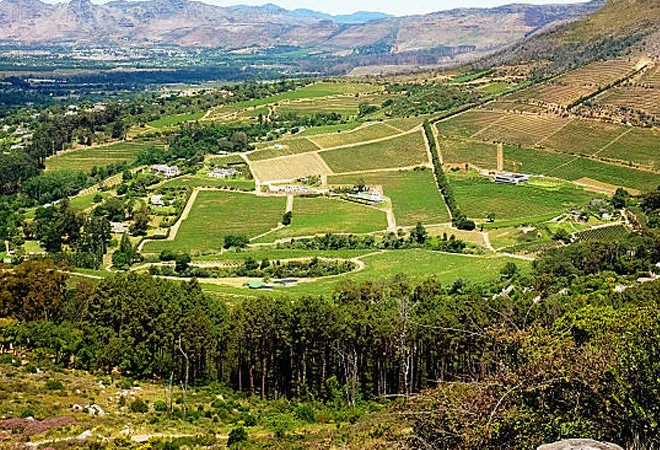
As the name indicates, peri-urban areas (PUAs) are areas at the periphery of cities. In India’s PUAs, different forms of settlement structures can be found, such as hamlets, villages, urban villages, slums, unauthorised colonies, and census towns. In addition, numerous planned housing colonies and townships have come up in PUAs due to availability of vacant land.
The rural characteristics of many PUAs adjoining large cities are undergoing a transformation with in-migration of population. People who are unable to live in cities due to high living costs or non-availability of houses reside here. Thus, PUAs are inhabited by the native population that is engaged in agro-based activities, as well as migrants, who pursue non-farm interests.
The transformation occurring in PUAs is seen in the form of increasing population densities, changes in land use and occupational patterns, reduced farmlands, and growth of built structures (residential, commercial, institutional, and industrial).
Many people living in PUAs benefit from this transformation. There is exchange of knowledge and ideas. New income generating activities come up. Several adverse impacts are also visible. This article describes the fundamental problems observed in peri-urban areas and suggests ideas to overcome them.
It may be said that when an ecosystem’s carrying capacity is pushed to the limits, it is bound to be affected. This is exactly what is happening in several peri-urban areas of India. These areas are under tremendous stress due to pressures created by urbanisation.
The first issue is indiscriminate conversion of land use. Open spaces, green areas, and farmlands are reducing, with the coming up of built structures and non-farm economic activities. The changes are negatively impacting the lives and livelihoods of the farming community, who end up looking for work in non-farm sectors. Case studies of PUAs in
Hubli-Dharwad,
Jammu, and
census towns of West Bengal highlight this concern.
The second problem is occurrence of unregulated development. There is haphazard growth of built structures due to high demand. Many buildings do not meet safety norms. Furthermore, there are instances of PUAs being colonised by private builders. They convince villagers to sell their land by offering attractive prices, and then acquire and carry out illegal sub-division of agricultural land and its disposal when land values rise. This has been noted in PUAs of
Hyderabad and
Chennai, where villagers have lost their land to real estate brokers who misled them.
Emergence of informal/unplanned structures in PUAs, such as slums and unauthorised colonies, is the third issue. They come up near planned residential or work areas. People living here are unable to buy or rent houses in planned areas. Many offer services of domestic help to the residents of neighbouring planned colonies, but their own living conditions are miserable. Examples of this type of development exist in Jaipur and
Faridabad.
Related to the above concern is inferior quality of life. In view of their illegal status, slums and unauthorised colonies remain uncovered by formal service delivery systems, such as water and sanitation. For this reason, people illegally extract groundwater to meet their needs. With increasing demand for water, the requirements of the native population, their crops, and livestock are affected.
The other issue is drainage. While there is uncontrolled construction of built structures, no provision is made for drainage. This leads to water logging, especially during the monsoon season, when the areas become breeding grounds for mosquitoes, leading to outbreaks of mosquito-borne diseases. Waste disposal is also improper. With no collection services available, people dump garbage at the periphery of agricultural fields.
Another issue is of women’s safety. Frequent incidents of harassment reduce their ability to contribute to city life and limits opportunities available to them.
Then, there are instances of population displacement. At times, the so called ‘unauthorised occupants’ living in slums and unauthorised colonies are evicted due to implementation of government infrastructure projects, such as regional road/rail corridors. This happened in Gurugram, near the periphery of Delhi, where
residents protested against the government’s policy. Many are unhappy with relocation to a new place. On other occasions, the native population, comprising small farmers/landless labourers, are displaced because of township development projects. Due to land use changes, their work has been affected.
Access to good and reliable public transport services is an equally important issue. Due to their peripheral location, many PUAs are not served properly by public transport. This has led to a steep rise in private vehicle ownership. The problem is noted in planned residential and work areas, where every working individual owns at least one motor vehicle. Further, where PUAs lie between two cities, such as Delhi and Gurugram, the motorists commuting in either direction use PUA roads as a short cut, which causes heavy congestion and air pollution.
The government, at various levels, has been making efforts to address the problems in PUAs. In Delhi, the Development Authority’s
land pooling policy aims to ensure planned development in PUAs. At the regional level, some metropolitan regions have formulated spatial plans for PUAs.
Amongst the states, the government of Uttarakhand, with support from the World Bank, has launched a
water supply programme to improve access for peri-urban residents. Projects have been initiated in PUAs of Dehradun, Roorkee, Haridwar, Haldwani, etc. In Haryana, the government aims to introduce the concept of peri-urban agriculture for supplying essential commodities, such as fresh vegetables, fruits, milk, and fish, to residents in neighbouring cities. For this purpose, the Russian government has sought
cooperation from Haryana.
At the national level,
Metropolitan Planning Committees (MPCs) proposed under the Constitution (74thAmendment Act) are required to look into matters of common interest between municipalities and panchayats, including coordinated spatial plans of the metropolitan area, which includes PUAs.
Then, the Ministry of Housing and Urban Affairs (MoHUA) has requested state governments to take steps towards
constituting municipalities in census towns, which are presently governed by rural governments to ensure better governance. In 2011, there were about 4,000 census towns, in which 54 million people or 14 percent of India’s population lived.
Further, the Union Ministry of Agriculture and Farmers Welfare (MoAFW) has taken steps to promote
food production and diversification in PUAs to improve supply of food to cities. The practice will help in price stabilisation of essential food commodities.
Under the National Rurban Mission, in the PUAs of Chhattisgarh, women have been empowered by way of training in activities such as handloom, bee keeping, poultry/pig rearing, amongst others. This has helped in employment generation.
Measures required
With India urbanising rapidly and with the scarcity of land in cities, the pressure on PUAs will continue to grow. The social, economic, and environmental adversities visible in many PUAs are an indication of the deficiencies in legislation, planning, and governance. Thus, efforts must be made to protect the traditional character of PUAs and guide future growth in an orderly manner. To improve the prevailing conditions, the following measures may be pursued:
- Existing reform initiatives at local/regional/state/national level should be scaled up.
- Rural-urban cooperation possibilities or partnerships should be explored.
- Statutory participatory plans should be prepared and implemented efficiently in peri-urban areas.
- Intangible contribution, especially the ecological role, of PUAs in making cities resilient must be taken into account during policy and plan formulation.
- Non-farm employment opportunities should be promoted amongst women in PUAs; gender-responsive interventions, such as dark spots, safety audits, awareness programmes, should be introduced.
- The many reasons responsible for occurrence of problems in PUAs, or the root causes, should be addressed. These pertain to areal extent of PUAs, land monitoring, enforcement, data, land use maps, development controls, building bye laws, funds, and technologies.
The views expressed above belong to the author(s). ORF research and analyses now available on Telegram! Click here to access our curated content — blogs, longforms and interviews.



 As the name indicates, peri-urban areas (PUAs) are areas at the periphery of cities. In India’s PUAs, different forms of settlement structures can be found, such as hamlets, villages, urban villages, slums, unauthorised colonies, and census towns. In addition, numerous planned housing colonies and townships have come up in PUAs due to availability of vacant land.
The rural characteristics of many PUAs adjoining large cities are undergoing a transformation with in-migration of population. People who are unable to live in cities due to high living costs or non-availability of houses reside here. Thus, PUAs are inhabited by the native population that is engaged in agro-based activities, as well as migrants, who pursue non-farm interests.
The transformation occurring in PUAs is seen in the form of increasing population densities, changes in land use and occupational patterns, reduced farmlands, and growth of built structures (residential, commercial, institutional, and industrial).
Many people living in PUAs benefit from this transformation. There is exchange of knowledge and ideas. New income generating activities come up. Several adverse impacts are also visible. This article describes the fundamental problems observed in peri-urban areas and suggests ideas to overcome them.
It may be said that when an ecosystem’s carrying capacity is pushed to the limits, it is bound to be affected. This is exactly what is happening in several peri-urban areas of India. These areas are under tremendous stress due to pressures created by urbanisation.
The first issue is indiscriminate conversion of land use. Open spaces, green areas, and farmlands are reducing, with the coming up of built structures and non-farm economic activities. The changes are negatively impacting the lives and livelihoods of the farming community, who end up looking for work in non-farm sectors. Case studies of PUAs in
As the name indicates, peri-urban areas (PUAs) are areas at the periphery of cities. In India’s PUAs, different forms of settlement structures can be found, such as hamlets, villages, urban villages, slums, unauthorised colonies, and census towns. In addition, numerous planned housing colonies and townships have come up in PUAs due to availability of vacant land.
The rural characteristics of many PUAs adjoining large cities are undergoing a transformation with in-migration of population. People who are unable to live in cities due to high living costs or non-availability of houses reside here. Thus, PUAs are inhabited by the native population that is engaged in agro-based activities, as well as migrants, who pursue non-farm interests.
The transformation occurring in PUAs is seen in the form of increasing population densities, changes in land use and occupational patterns, reduced farmlands, and growth of built structures (residential, commercial, institutional, and industrial).
Many people living in PUAs benefit from this transformation. There is exchange of knowledge and ideas. New income generating activities come up. Several adverse impacts are also visible. This article describes the fundamental problems observed in peri-urban areas and suggests ideas to overcome them.
It may be said that when an ecosystem’s carrying capacity is pushed to the limits, it is bound to be affected. This is exactly what is happening in several peri-urban areas of India. These areas are under tremendous stress due to pressures created by urbanisation.
The first issue is indiscriminate conversion of land use. Open spaces, green areas, and farmlands are reducing, with the coming up of built structures and non-farm economic activities. The changes are negatively impacting the lives and livelihoods of the farming community, who end up looking for work in non-farm sectors. Case studies of PUAs in  PREV
PREV


